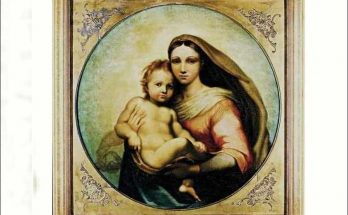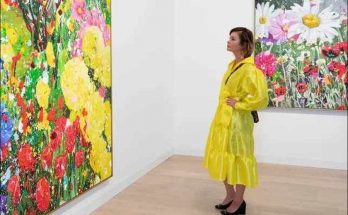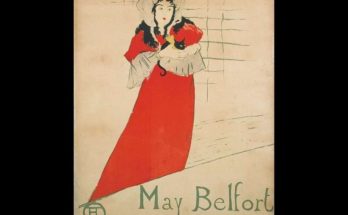Andy Warhol befriended actresses, filmmakers, models, musicians and singers. Some achieved fame while others were ill-fated comets who streaked only briefly across tabloid headlines.
Now, nine creative women who influenced the Pittsburgh-born Pop artist are the subject of a new exhibition, “Femme Touch,” on view at The Andy Warhol Museum through Jan. 3. Organized by chief curator Jose Carlos Diaz, this excellent show features stunning photographs, digitally remastered color film footage and a dazzling array of portraits.
The North Side museum’s galleries have a “classy trashy” feel created by Erin Foster, a local graphic designer who blended diner decor and movie house mystery with coral neon signs glowing on walls painted a dark eggplant shade.
The show begins with Warhol’s mother, Julia, dressed in a round hat, a string of pearls and a going-to-church dress. Photographer Duane Michals’ affectionate portrait in Warhol’s Manhattan apartment conveys the lifelong bond between the doting mother and the shy boy she rewarded with a Hershey’s candy bar every time he finished a page in a coloring book.
Julia Warhola introduced her son to the Sunday comics and bought comic books that later influenced his art. She spent $9 — nine days of housecleaning wages — on a home movie projector that he used to screen movies of Mickey and Minnie Mouse. The budding artist created a scrapbook of Hollywood stars with autographed pictures of Shirley Temple, Carmen Miranda, Mae West and many other actresses, according to a Warhol biography published this year by author Blake Gopnik.
Ultimately, the gay artist’s fascination with celebrity, fashion and movie stars inspired his screen prints of Marilyn Monroe and Jacqueline Kennedy Onassis plus an entire galaxy of famous women from various fields who appear in the show’s final gallery.
In the 1960s and ’70s, Warhol cast strong women in his films and easily named his three favorite women artists — Lynda Benglis, Alice Neel and Louise Nevelson, according to Mr. Gopnik’s biography. His female friends included a wealthy debutante, two super models, a revolutionary filmmaker and a radical feminist. A team of curators researched each person featured and most of the art, artifacts, film and video are from the museum’s collection.
“These individuals are really fascinating,” Mr. Diaz said. “I didn’t know who Donna Jordan and Jane Forth were until I looked at their photos. They were some of the leading American super models. Warhol found them fascinating enough to use them as stars in a film in France.”
Chris Von Wangenheim’s photographic portraits of Forth and a blonde, bikini-clad Jordan, who appeared in the French edition of Vogue, have an aura of lush splendor. Along with Jerry Hall, Grace Jones and Jessica Lange, the two models were discovered by fashion illustrator Antonio Lopez. Forth and Jordan starred in “L’Amour,” a 1973 romantic comedy Warhol shot in Paris that included fashion designer Karl Lagerfeld.
“Femme Touch” features ephemera and clothing from Tally Brown, a flamboyant actress, trained opera singer and civil rights activist. The Juilliard-educated vocalist sang ballads, blues, jazz and performed on and off Broadway.
Brown appeared in four Warhol films and made her own plus-sized clothes. Her black matching top and pants ensemble are displayed on a mannequin topped by a big, curly black wig and a large set of earrings. The Warhol museum acquired her personal effects from Timothy Greenfield-Sanders, an acclaimed documentary filmmaker and portrait photographer.
In New York City, Warhol met Brigid Berlin, a former debutante who dipped her breasts into paint to make prints; Mario Montez, a drag performer who played a banana-eating Jean Harlow; and Barbara Rubin, a cultural matchmaker and experimental filmmaker.
Berlin began working at Warhol’s studio in 1975 and remained his friend until he died in 1987. She talked with Warhol nearly every day and a black-and-white portrait shows how comfortable they were with each other.
Montez worked at office jobs but excelled as a drag, stage and film performer who took his name as an homage to the Dominican movie star Maria Montez, the Queen of Technicolor. “Mario identified as male,” Mr. Diaz said, adding that the drag performer called his artistry “going into costume.”
Warhol admired the conceptual thinking of Rubin, an experimental filmmaker who made “Christmas on Earth.” Rubin, who introduced him to musicians Bob Dylan and Lou Reed and poet Alan Ginsberg, moved to France, became a Hasidic Jew and died at age 35.
Also part of the scene was Candy Darling, a transgender woman and actress who exuded glamour and appeared in two of Warhol’s films. A gallery devoted to her life includes gowns that typified her style.
Warhol’s most volatile acquaintance was Valerie Solanas, a radical feminist who critiqued America’s patriarchal culture in her “SCUM Manifesto.” She starred in a 1967 Warhol film, “I, A Man,” but became upset with the artist after he lost a script for a play she wrote. Solanas, who suffered from paranoid delusions, believed that Warhol had designs on the play, according to Gopnik’s biography.
She shot Warhol on a New York street in June 1968, an attack that nearly killed him. A gallery devoted to Solanas features film footage of her arrest and a giant poster version of the New York Daily News front page with the headline “Actress Shoots Andy Warhol.”
Due to the pandemic, no headphones are used with the exhibit so all of the film footage is silent. The absence of sound allows viewers to focus on how conscious of the camera Warhol’s friends were when it was trained on them.
The show’s colorful portraits of Black drag performer Wilhelmina Ross are from the artist’s “Ladies and Gentlemen” series. Ross appeared in 73 of the portraits; Italian art dealer Luciano Anselmino paid Warhol $905,000 for the canvases.
The exhibition’s last section, “My Fair Ladies,” features a three-minute color screen test of Edie Sedgwick, an actress and model who starred in several of Warhol’s short films in the 1960s. Then comes a wide array of Warhol portraits including Judy Garland, Lana Turner, Jane Fonda and Aretha Franklin. The Queen of Soul appears in vivid hues and was the last one Warhol did
Visits: 113



